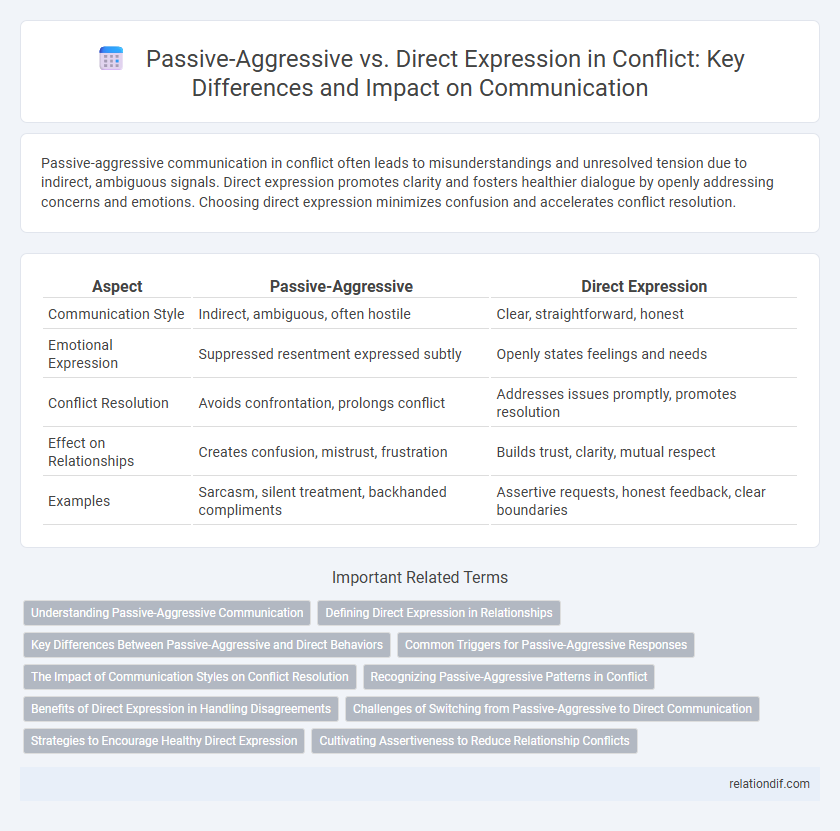Passive-aggressive communication in conflict often leads to misunderstandings and unresolved tension due to indirect, ambiguous signals. Direct expression promotes clarity and fosters healthier dialogue by openly addressing concerns and emotions. Choosing direct expression minimizes confusion and accelerates conflict resolution.
Table of Comparison
| Aspect | Passive-Aggressive | Direct Expression |
|---|---|---|
| Communication Style | Indirect, ambiguous, often hostile | Clear, straightforward, honest |
| Emotional Expression | Suppressed resentment expressed subtly | Openly states feelings and needs |
| Conflict Resolution | Avoids confrontation, prolongs conflict | Addresses issues promptly, promotes resolution |
| Effect on Relationships | Creates confusion, mistrust, frustration | Builds trust, clarity, mutual respect |
| Examples | Sarcasm, silent treatment, backhanded compliments | Assertive requests, honest feedback, clear boundaries |
Understanding Passive-Aggressive Communication
Passive-aggressive communication manifests through indirect expressions of anger or resentment, such as sarcasm, procrastination, or silent treatment, often causing confusion and eroding trust in conflicts. Recognizing these subtle behaviors is crucial for addressing underlying issues without escalating tensions, as they mask true feelings and obstruct constructive dialogue. Effective conflict resolution requires identifying passive-aggressive patterns to encourage honest, direct expression and foster healthier interpersonal relationships.
Defining Direct Expression in Relationships
Direct expression in relationships involves openly and honestly communicating feelings, needs, and concerns without ambiguity or hidden meanings. This communication style promotes clarity and reduces misunderstandings by addressing issues head-on rather than using indirect or passive-aggressive behaviors. Establishing direct expression fosters trust, emotional intimacy, and effective conflict resolution between partners.
Key Differences Between Passive-Aggressive and Direct Behaviors
Passive-aggressive behavior involves indirect resistance, such as procrastination or sarcasm, to express negative feelings without openly addressing the issue, often causing confusion and prolonged conflict. In contrast, direct expression clearly communicates thoughts and emotions assertively and honestly, promoting transparency and quicker resolution. Understanding these key differences helps improve conflict management by encouraging more straightforward communication and reducing misunderstandings.
Common Triggers for Passive-Aggressive Responses
Common triggers for passive-aggressive responses include feelings of resentment, unmet expectations, and perceived unfair treatment in conflict situations. Individuals often resort to indirect communication when they fear confrontation or believe their concerns will be dismissed. This behavior can escalate misunderstandings and hinder effective conflict resolution.
The Impact of Communication Styles on Conflict Resolution
Passive-aggressive communication often leads to misunderstandings and prolonged conflict by masking true feelings and intentions, which hinders effective resolution. Direct expression promotes clarity, enabling parties to address issues openly and collaboratively, increasing the likelihood of mutual understanding and compromise. Studies show that direct communication reduces the escalation of conflicts and fosters healthier interpersonal relationships in both personal and professional contexts.
Recognizing Passive-Aggressive Patterns in Conflict
Passive-aggressive behavior in conflict often manifests as indirect resistance, subtle sarcasm, or intentional procrastination, making it difficult to address issues openly. Key signs include withholding information, backhanded compliments, and nonverbal cues like eye-rolling or silent treatment. Recognizing these patterns allows for clearer communication and more effective conflict resolution by shifting toward direct expression.
Benefits of Direct Expression in Handling Disagreements
Direct expression in handling disagreements promotes clear communication, reducing misunderstandings and fostering mutual respect. It enables individuals to address issues promptly, preventing resentment and escalating conflicts. Emphasizing honesty and assertiveness enhances relationship trust and encourages collaborative problem-solving.
Challenges of Switching from Passive-Aggressive to Direct Communication
Switching from passive-aggressive to direct communication poses significant challenges, including overcoming ingrained habits of indirect expression and managing fear of confrontation. Individuals often encounter difficulty in articulating their needs openly due to anxiety about negative reactions or escalation of conflict. Developing assertiveness and emotional regulation skills is essential for fostering transparent and effective dialogue in conflict resolution.
Strategies to Encourage Healthy Direct Expression
Encouraging healthy direct expression involves fostering an environment where individuals feel safe articulating their thoughts and emotions without fear of judgment or retaliation. Implementing active listening techniques and promoting assertive communication skills help reduce passive-aggressive behaviors by creating clarity and mutual respect. Establishing clear boundaries and providing constructive feedback further supports honest dialogue, enhancing conflict resolution and strengthening relationships.
Cultivating Assertiveness to Reduce Relationship Conflicts
Cultivating assertiveness involves expressing needs and feelings directly and respectfully, which reduces misunderstandings common in passive-aggressive communication. Research shows that assertive communication enhances emotional clarity, fosters mutual respect, and minimizes relationship conflicts. Developing assertiveness skills leads to healthier interactions and more effective conflict resolution in both personal and professional relationships.
Passive-aggressive vs Direct Expression Infographic

 relationdif.com
relationdif.com